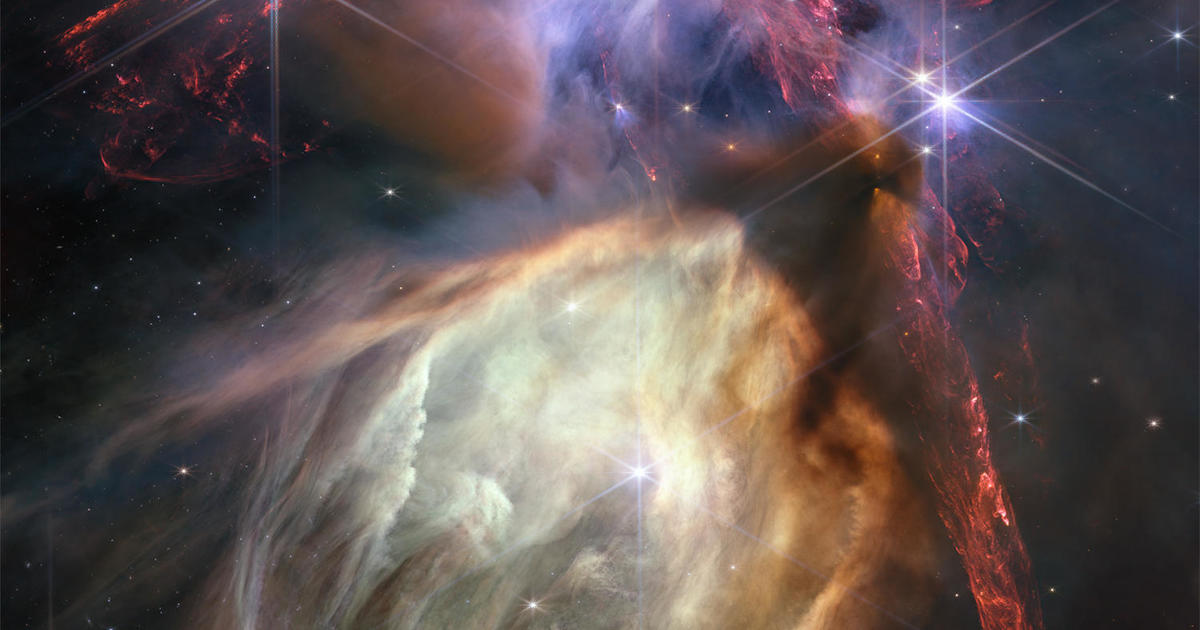James Webb Space Telescope captures spectacular image of nearby stellar nursery
 [ad_1]
[ad_1]
Marking the one-year anniversary of science observations with the $10 billion James Webb Space Telescope, NASA released a spectacular new image Wednesday showing the closest star-forming region to Earth, a colorfully chaotic tapestry of swirling gas studded with sun-like stars.
The stellar nursery in the Rho Ophiuchi cloud complex features about 50 young stars, all similar to Earth's sun or smaller.
"The darkest areas are the densest, where thick dust cocoons still-forming protostars," NASA said in a description of the photo, captured by Webb's Near Infrared Camera, or NIRCam.
"Huge bipolar jets of molecular hydrogen, represented in red, dominate the image, appearing horizontally across the upper third and vertically on the right. These occur when a star first bursts through its natal envelope of cosmic dust, shooting out a pair of opposing jets into space."
Webb project scientist Klaus Pontoppidan said the image "allows us to witness a very brief period in the stellar lifecycle with new clarity. Our own sun experienced a phase like this, long ago, and now we have the technology to see the beginning of another star's story."
Said NASA Administrator Bill Nelson: "In just one year, the James Webb Space Telescope has transformed humanity's view of the cosmos, peering into dust clouds and seeing light from faraway corners of the universe for the very first time. Every new image is a new discovery."
The James Webb Space Telescope was launched atop an Ariane 5 rocket on Christmas Day, 2021, from the European Space Agency's Kourou, French Guiana, launch site.
It took a month for the telescope to reach its planned parking place a million miles from Earth on the far side of the moon's orbit — Lagrange Point 2 — where it now circles the sun in gravitational lockstep with Earth, providing the cold, dark environment needed for mission success.
The most complex civilian science probe ever built, Webb was folded up to fit inside the Ariane 5's nose cone. On the way to Lagrange Point 2, scientists and engineers held their collective breath as the telescope unfurled a complex tennis court-size sunshade to cool the observatory to within 50 degrees of absolute zero.
Six hexagonal side segments of Webb's 21.3-foot-wide primary mirror then were deployed and the optical system precisely aligned to produce razor-sharp images.
The telescope and its four instruments are optimized to capture light from the first stars and galaxies that began shining in the aftermath of the Big Bang birth of the cosmos, light that has been stretched into the infrared region of the spectrum by the expansion of space itself over the past 13.8 billion years.
That light can't be seen by current ground-based telescopes or even the iconic Hubble, which was designed primarily to study visible and near-infrared wavelengths. Even so, Hubble has detected galaxies dating back to within a half billion years or so of the Big Bang, earlier than astronomers expected.
Webb was designed to push well past that milestone. If, that is, everything worked exactly as planned.
The telescope's sheer complexity prompted widespread tension among the astronomical community. But six-and-a-half months after launch, Webb was fully calibrated and operating as designed. NASA was able to release five initial images on July 12, 2022, that clearly demonstrated the enormous power of the most expensive science probe ever built.
In its first year of operation, Webb has looked deeper into space and further back in time than ever before, detecting at least one galaxy that was shining just 390 million years after the Big Bang. It's a record that likely won't stand for long with several other candidates awaiting confirmation.
Webb also has spotted the earliest known supermassive black hole powering a quasar that was blazing away 570 million years after the birth of the universe. The discoveries are sending researchers back to the drawing board to understand how galaxies and supermassive black holes could form so "soon" after the the cosmos exploded into existence.
Along with pushing further back in time and space, Webb also has turned its infrared eye on planets in Earth's solar system, capturing stunning infrared views of Jupiter, Saturn, Uranus and Neptune amid spectroscopic studies helping researchers map out elements and compounds in the atmospheres of planets orbiting other stars.
"On its first anniversary, the James Webb Space Telescope has already delivered upon its promise to unfold the universe, gifting humanity with a breathtaking treasure trove of images and science that will last for decades," NASA science director Nicola Fox said in a statement.
"Webb has given us a more intricate understanding of galaxies, stars and the atmospheres of planets outside of our solar system than ever before, laying the groundwork for NASA to lead the world in a new era of scientific discovery and the search for habitable worlds."



Comments
Post a Comment